BREAST SELF-EXAMINATION ( BSE )
REMEMBER, BSE IS NOT A SUBSTITUTE FOR ROUTINE THERMOGRAMS, MAMMOGRAMS OR REGULAR BREAST EXAMS BY A DOCTOR.
Breast self-examination should be done once a month so you become familiar with the usual appearance and feel of your breasts. Familiarity makes it easier to notice any changes in the breast from one month to another. Early discovery of a change from what is "normal" is the main idea behind BSE. The outlook is much better if you detect cancer in an early stage. If you menstruate, the best time to do BSE is 2 or 3 days after your period ends, when your breasts are least likely to be tender or swollen. If you no longer menstruate, pick a day such as the first day of the month, to remind yourself it is time to do BSE.
Here is one way to do BSE:
Stand before a mirror. Inspect both breasts for anything unusual such as any discharge from the nipples or puckering, dimpling, or scaling of the skin.
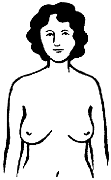
The next two steps are designed to emphasize any change in the shape or contour of your breasts. As you do them, you should be able to feel your chest muscles tighten.
Watching closely in the mirror, clasp your hands behind your head and press your hands forward.
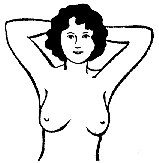
Next, press your hands firmly on your hips and bow slightly toward your mirror as you pull your shoulders and elbows forward.
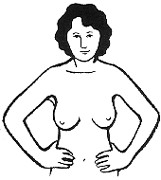
Some women do the next part of the exam in the shower because fingers glide over soapy skin, making it easy to concentrate on the texture underneath.
Raise your left arm. Use three or four fingers of your right hand to explore your left breast firmly, carefully, and thoroughly. Beginning at the outer edge, press the flat part of your fingers in small circles, moving the circles slowly around the breast. Gradually work toward the nipple. Be sure to cover the entire breast. Pay special attention to the area between the breast and the underarm, including the underarm itself. Feel for any unusual lump or mass under the skin.
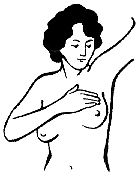
Gently squeeze the nipple and look for a discharge. (If you have any discharge during the month – whether or not it is during BSE – see your doctor.) Repeat steps 4 and 5 on your right breast.
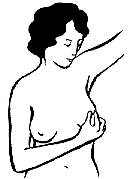
Steps 4 and 5 should be repeated lying down. Lie flat on your back with your left arm over your head and a pillow or folded towel under your left shoulder. This position flattens the breast and makes it easier to examine. Use the same circular motion described earlier. Repeat the exam on your right breast.

The earliest sign of breast cancer is a single painless firm to hard lump. The edges of the lump are not sharp and stretch out gradually into the surrounding tissue if felt between the fingers. Erosion of the nipple or discharge may indicate an early cancer. Late signs of cancer include an inability to move the lump which appears attached to the skin or to the deeper breast tissue. There may be puckering of the skin above the cancer or retraction of the nipple. Eventually there will be breast enlargement, hardness, inflammation and pain. Almost half of breast cancers begin in the nipple or outer and upper quarter of the breast. The earlier a cancer of the breast is discovered, the better the chances of a complete recovery.